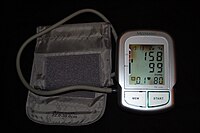
Photo from wikipedia
BACKGROUND Growing evidence exists about the fetal and environmental origins of hypertension, but mainly limited to single-exposure studies. The exposome has been proposed as a more holistic approach by studying… Click to show full abstract
BACKGROUND Growing evidence exists about the fetal and environmental origins of hypertension, but mainly limited to single-exposure studies. The exposome has been proposed as a more holistic approach by studying many exposures simultaneously. OBJECTIVES This study aims to evaluate the association between a wide range of prenatal and postnatal exposures and blood pressure (BP) in children. METHODS Systolic and diastolic BP were measured among 1,277 children from the European HELIX (Human Early-Life Exposome) cohort aged 6 to 11 years. Prenatal (n = 89) and postnatal (n = 128) exposures include air pollution, built environment, meteorology, natural spaces, traffic, noise, chemicals, and lifestyles. Two methods adjusted for confounders were applied: an exposome-wide association study considering the exposures independently, and the deletion-substitution-addition algorithm considering all the exposures simultaneously. RESULTS Decreases in systolic BP were observed with facility density (β change for an interquartile-range increase in exposure: -1.7 mm Hg [95% confidence interval (CI): -2.5 to -0.8 mm Hg]), maternal concentrations of polychlorinated biphenyl 118 (-1.4 mm Hg [95% CI: -2.6 to -0.2 mm Hg]) and child concentrations of dichlorodiphenyldichloroethylene (DDE: -1.6 mm Hg [95% CI: -2.4 to -0.7 mm Hg]), hexachlorobenzene (-1.5 mm Hg [95% CI: -2.4 to -0.6 mm Hg]), and mono-benzyl phthalate (-0.7 mm Hg [95% CI: -1.3 to -0.1 mm Hg]), whereas increases in systolic BP were observed with outdoor temperature during pregnancy (1.6 mm Hg [95% CI: 0.2 to 2.9 mm Hg]), high fish intake during pregnancy (2.0 mm Hg [95% CI: 0.4 to 3.5 mm Hg]), maternal cotinine concentrations (1.2 mm Hg [95% CI: -0.3 to 2.8 mm Hg]), and child perfluorooctanoate concentrations (0.9 mm Hg [95% CI: 0.1 to 1.6 mm Hg]). Decreases in diastolic BP were observed with outdoor temperature at examination (-1.4 mm Hg [95% CI: -2.3 to -0.5 mm Hg]) and child DDE concentrations (-1.1 mm Hg [95% CI: -1.9 to -0.3 mm Hg]), whereas increases in diastolic BP were observed with maternal bisphenol-A concentrations (0.7 mm Hg [95% CI: 0.1 to 1.4 mm Hg]), high fish intake during pregnancy (1.2 mm Hg [95% CI: -0.2 to 2.7 mm Hg]), and child copper concentrations (0.9 mm Hg [95% CI: 0.3 to 1.6 mm Hg]). CONCLUSIONS This study suggests that early-life exposure to several chemicals, as well as built environment and meteorological factors, may affect BP in children.
Journal Title: Journal of the American College of Cardiology
Year Published: 2019
Link to full text (if available)
Share on Social Media: Sign Up to like & get
recommendations!